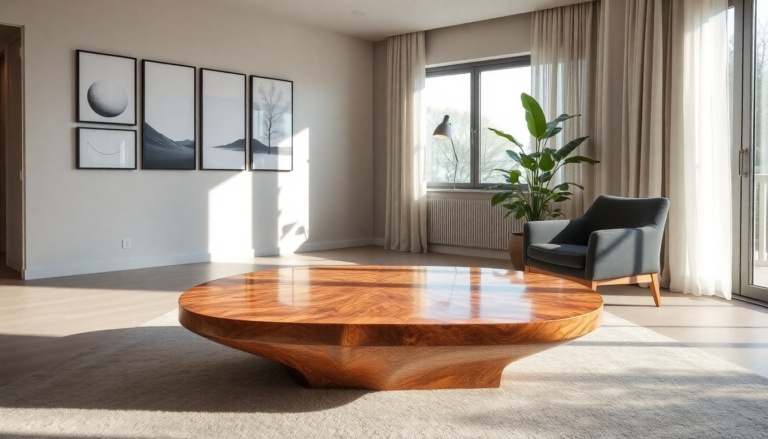Argomenti trattati
In the ever-evolving world of interior design, some materials manage to stand the test of time, captivating both designers and homeowners alike. One such material making a strong comeback is burl wood. Known for its distinctive grain patterns and luxurious vibe, burl wood adds a touch of sophistication and warmth to any space. But why is this material suddenly back in the spotlight? Let’s explore how burl wood is not just a nostalgic throwback but also a perfect match for modern aesthetics.
The Allure of Burl Wood
What makes burl wood so appealing? Its intricacy is truly a sight to behold. Each piece displays a unique pattern, a fascinating result of growth deformities on trees that create stunning knots and swirls. Interior designer Hema Persad from Sagrada Studio notes that these distinctive features arise from stress caused by injury or infection, making burl wood a rare gem in the furniture market. This uniqueness guarantees that no two pieces are the same, adding an exclusive touch to any interior.
From a design perspective, burl wood fits seamlessly into various styles. It channels a nostalgic ’70s vibe that complements everything from traditional to contemporary settings, as well as mid-century designs. This versatility allows homeowners to mix and match burl wood furniture with different decor styles. Who wouldn’t want a timeless piece that effortlessly blends with their existing decor?
Moreover, burl wood offers a variety of finishes—from light ivory to deep brown—making it adaptable to a wide range of color palettes. Its dense structure not only enhances durability but also signifies high-quality craftsmanship, making it a smart investment for those who appreciate the finer things in life.
Data-Driven Insights into Consumer Preferences
Having worked as a Google Ads specialist, I’ve seen how consumer tastes evolve over time. The current shift towards maximalism is reflected in the rising popularity of bold materials like burl wood. Data from various market analyses reveal that furniture featuring unique textures and patterns, such as burl wood, is enjoying higher engagement rates and conversions. Isn’t it fascinating how numbers can tell us so much about what people want?
For example, platforms like Google Marketing Platform show that products boasting visually striking characteristics often achieve better click-through rates (CTR) and return on ad spend (ROAS). This data-driven insight is crucial for marketers looking to align their strategies with what consumers are truly interested in.
Furthermore, the explosion of social media has opened doors for unique design elements to shine. Home decor influencers often showcase burl wood pieces, creating buzz and desire among their followers. This organic promotion underscores the importance of blending data analytics with creative storytelling in today’s marketing landscape.
Implementing Burl Wood into Your Home
If you’re eager to bring burl wood into your living space, starting small is a great way to go. Interior designers often suggest kicking things off with accent pieces, like side tables or decorative lamps. For instance, a burl wood lamp can serve as a subtle yet striking statement piece, adding warmth and texture to your room. Have you ever considered how a single piece can transform the feel of a space?
When choosing burl wood furniture, it’s vital to pay attention to quality and craftsmanship. Look for items that don’t show signs of splitting or damage; these flaws can detract from both the aesthetic appeal and durability of your furniture. Prioritizing quality ensures that your investment lasts for years to come.
As you curate your space, aim for a balance between burl wood’s bold texture and complementary decor elements. This strategy allows the wood’s natural beauty to shine, enhancing its visual impact while maintaining a cozy atmosphere.
Key Performance Indicators for Monitoring Trends
To effectively track the success of incorporating burl wood into your design strategy, keep an eye on a few key performance indicators (KPIs). Engagement metrics, such as social media interactions and website traffic related to burl wood products, offer valuable insights into consumer interest. Additionally, digging into sales data can reveal trends in purchasing behavior and preferences.
Moreover, consider conducting customer feedback surveys to gauge satisfaction levels and pinpoint areas for improvement. By weaving these insights into your marketing and design strategies, you can align your offerings with consumer desires, ensuring a successful integration of burl wood into your home decor. Isn’t it exciting to think about how data can enhance your design choices?

